
We've been showing this chart frequently. It shows us a close up view of our Swenlin Trading Oscillators (STOs) and the Intermediate-Term Breadth Momentum (ITBM) and Intermediate-Term Volume Momentum (ITVM) Oscillators. The short-term STOs have been trending lower as price has moved higher, while the ITBM/ITVM have been rising.
Today we got mixed messages as the breadth indicators moved higher while volume indicators moved lower. We are cautiously optimistic given the upside reversal for the STO-B, but seeing the ITVM turn lower out of overbought territory is concerning. This could be another case of indicators unwinding as price trickles higher and consolidates. Still, we would be cautious as the deadly drop in June was preceded by both the ITBM/ITVM indicators turning down.
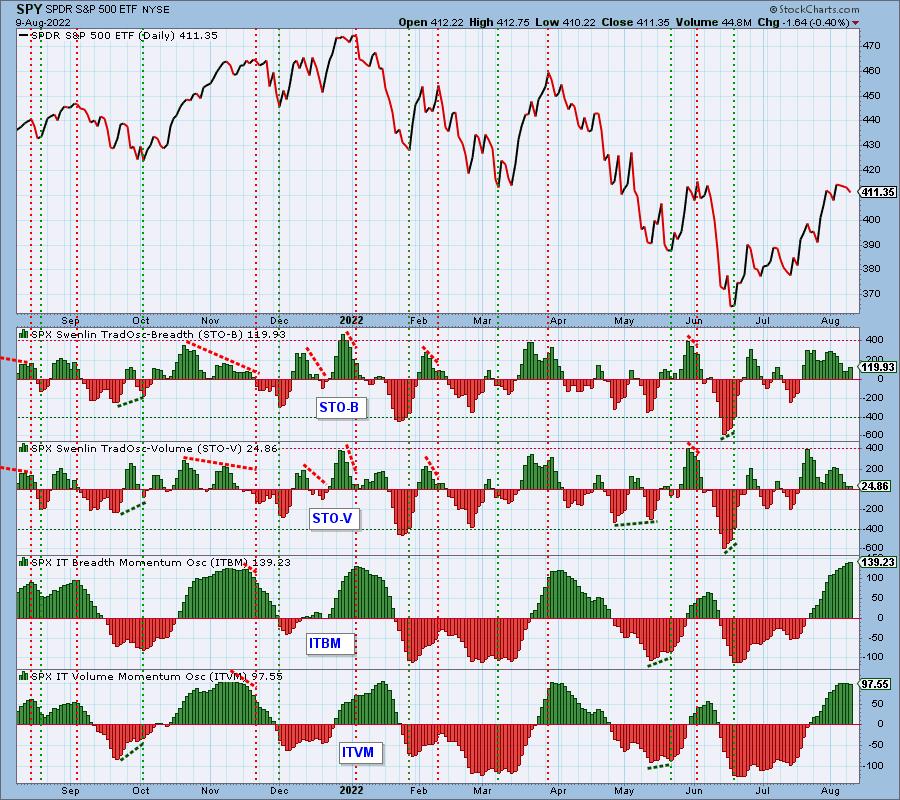
The DecisionPoint Alert Weekly Wrap presents an end-of-week assessment of the trend and condition of the Stock Market, the U.S. Dollar, Gold, Crude Oil, and Bonds. The DecisionPoint Alert daily report (Monday through Thursday) is abbreviated and gives updates on the Weekly Wrap assessments.
Watch the latest episode of DecisionPoint on StockCharts TV's YouTube channel here!
MAJOR MARKET INDEXES

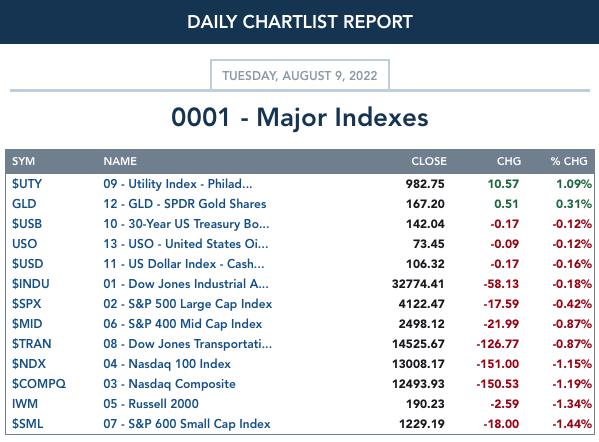
SECTORS
Each S&P 500 Index component stock is assigned to one of 11 major sectors. This is a snapshot of the Intermediate-Term (Silver Cross) and Long-Term (Golden Cross) Trend Model signal status for those sectors.
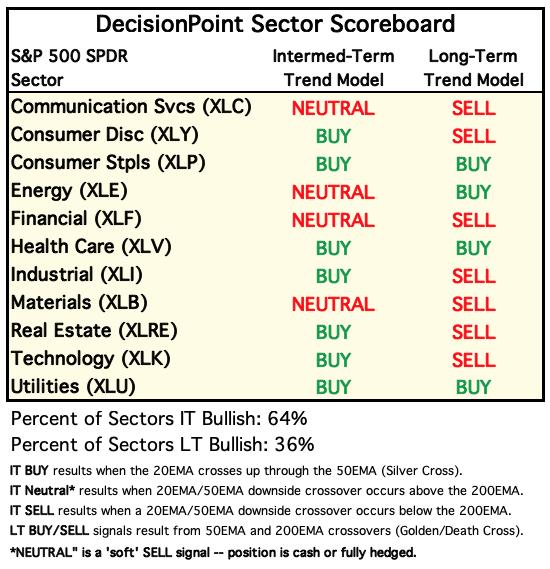
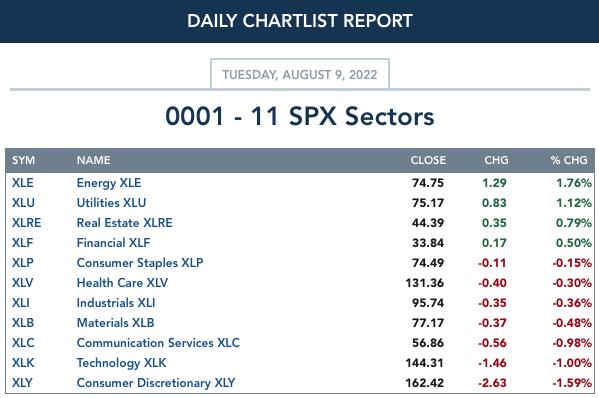
RRG® Chart ($ONE Benchmark):
Daily:
All sectors are now in the Leading quadrant. Some are stronger than others based on their heading. XLE looks weakest as it heads toward the Weakening quadrant. XLB is also questionable given its southeast heading. While XLI doesn't have a bullish northeast heading, it is further away from the center meaning it is still outperforming most of the sectors. The rest have bullish northeast headings.
XLV is the only sector not in the Leading quadrant. It is directionless so we can't make any sweeping conclusions.
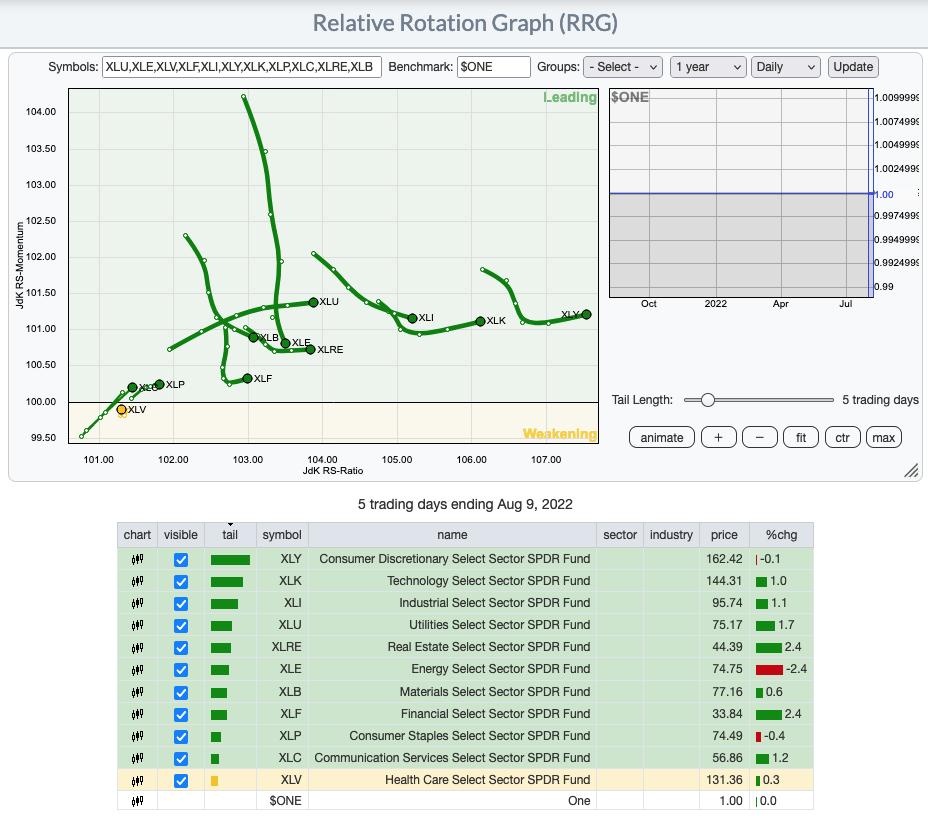
Weekly: Yesterday's comments still apply:
The weakest sector is clearly Energy (XLE). It has a strong bearish southwest heading that is taking it further into the Lagging quadrant.
XLB and XLU look suspect. XLB is taking its time leaving the Lagging quadrant given its strong westward heading. XLP is in the Lagging quadrant, but it should hit Improving quadrant very soon. XLU has a strong enough northward heading to get it into the Improving quadrant, but it likely will have to move through Lagging to do it.
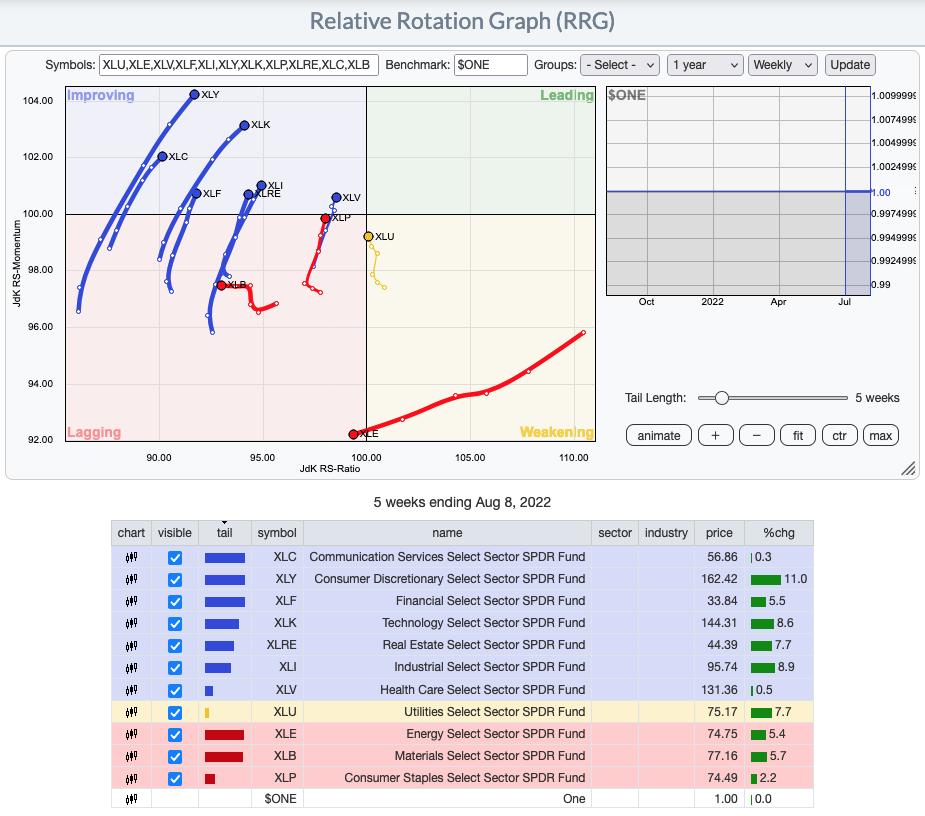
RRG® charts show you the relative strength and momentum for a group of stocks. Stocks with strong relative strength and momentum appear in the green Leading quadrant. As relative momentum fades, they typically move into the yellow Weakening quadrant. If relative strength then fades, they move into the red Lagging quadrant. Finally, when momentum starts to pick up again, they shift into the blue Improving quadrant.
CLICK HERE for an animated version of the RRG chart.
CLICK HERE for Carl's annotated Sector charts.
THE MARKET (S&P 500)
IT Trend Model: BUY as of 8/2/2022
LT Trend Model: SELL as of 5/5/2022
SPY Daily Chart: The short-term bearish rising wedge is nearing confirmation with a breakdown from the rising trend. Despite selling, the RSI remains comfortably within positive territory and the PMO is still rising. We note a bearish divergence between the OBV tops and price tops. The VIX does remain above its moving average on our inverted scale so there is still internal strength.

Stochastics have turned down but are still above 80. Total Volume is below the annual average yet again. We do like seeing selling volume decreasing.
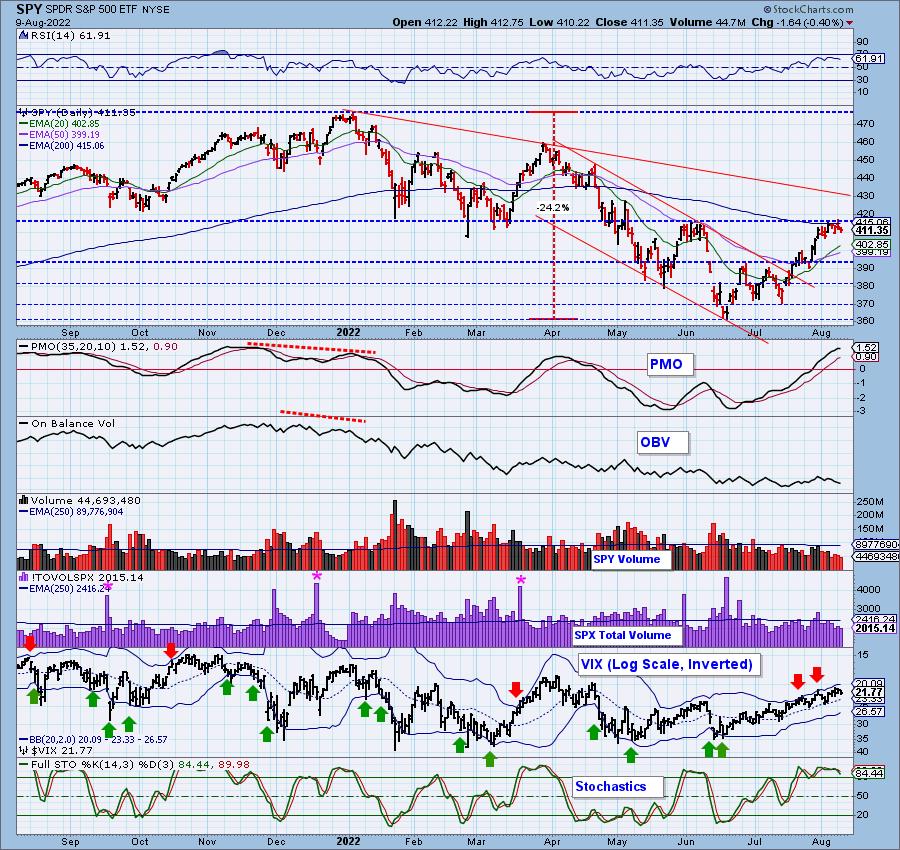
Here is the latest recording:
S&P 500 New 52-Week Highs/Lows: Yesterday's comments still apply:
"Despite a decline, we did see more New Highs. Of course we must remember that these are intraday readings. This means that the highest reading of the day is recorded, not necessarily the last reading of the day. The 10-DMA of the High-Low Differential is flat and not hinting at future price movement."
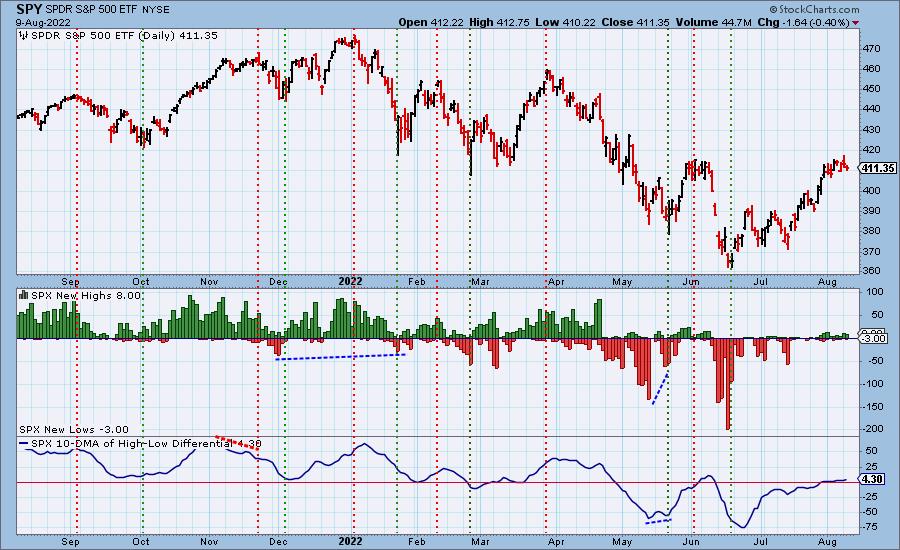
Climax* Analysis: There were no climax readings today.
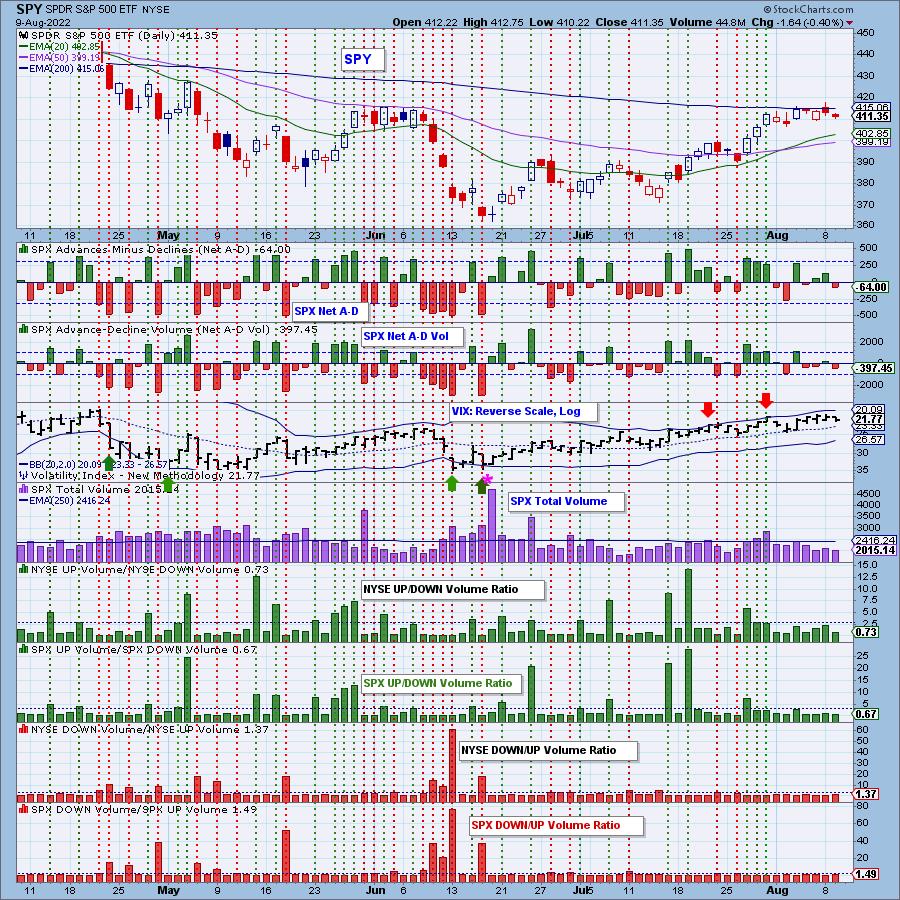
*A climax is a one-day event when market action generates very high readings in, primarily, breadth and volume indicators. We also include the VIX, watching for it to penetrate outside the Bollinger Band envelope. The vertical dotted lines mark climax days -- red for downside climaxes, and green for upside. Climaxes are at their core exhaustion events; however, at price pivots they may be initiating a change of trend.
Short-Term Market Indicators: The short-term market trend is UP and the condition is NEUTRAL.
We see negative divergences between STOs and price tops. However, as noted in the opening, the STO-B did turn back up. Participation is beginning to shrink. 12% lost their rising PMOs since yesterday.
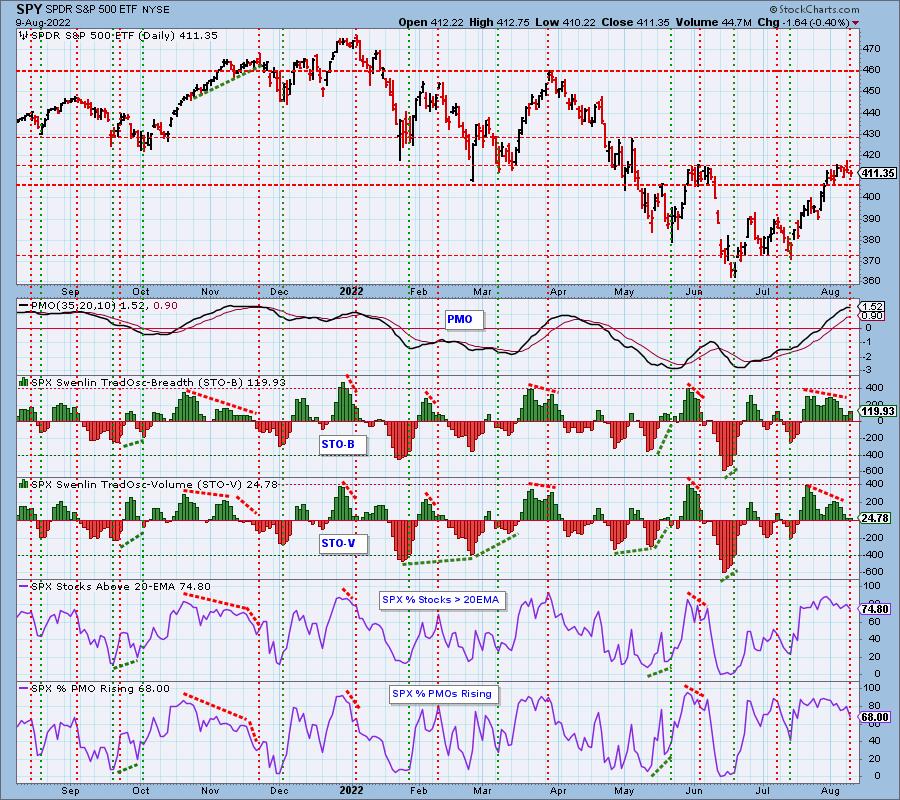
Intermediate-Term Market Indicators: The intermediate-term market trend is UP and the condition is OVERBOUGHT.
We only saw 1% of stocks lose their PMO BUY signals today and the ITBM continues higher. On the negative side, the ITVM did turn lower and all of these indicators are overbought.

PARTICIPATION and BIAS Assessment: The following chart objectively shows the depth and trend of participation in two time frames.
- Intermediate-Term - the Silver Cross Index (SCI) shows the percentage of SPX stocks on IT Trend Model BUY signals (20-EMA > 50-EMA). The opposite of the Silver Cross is a "Dark Cross" -- those stocks are, at the very least, in a correction.
- Long-Term - the Golden Cross Index (GCI) shows the percentage of SPX stocks on LT Trend Model BUY signals (50-EMA > 200-EMA). The opposite of a Golden Cross is the "Death Cross" -- those stocks are in a bear market.
The short-term bias is bullish given we have 74.8% of stocks above their 20-day and 69.8% above their 50-day EMAs. These percentages are much higher than the SCI reading of 59.6%. This implies that the SCI could continue higher.
The intermediate-term bias is bullish. While the SCI reading of 59.6% isn't above the 70% bullish threshold, it is healthy and rising.
The long-term bias is bearish but improving. We have 44% of stocks with price above their 200-day EMA and that is higher than the GCI reading of 30%. The GCI has had a positive crossover its signal line and is rising.
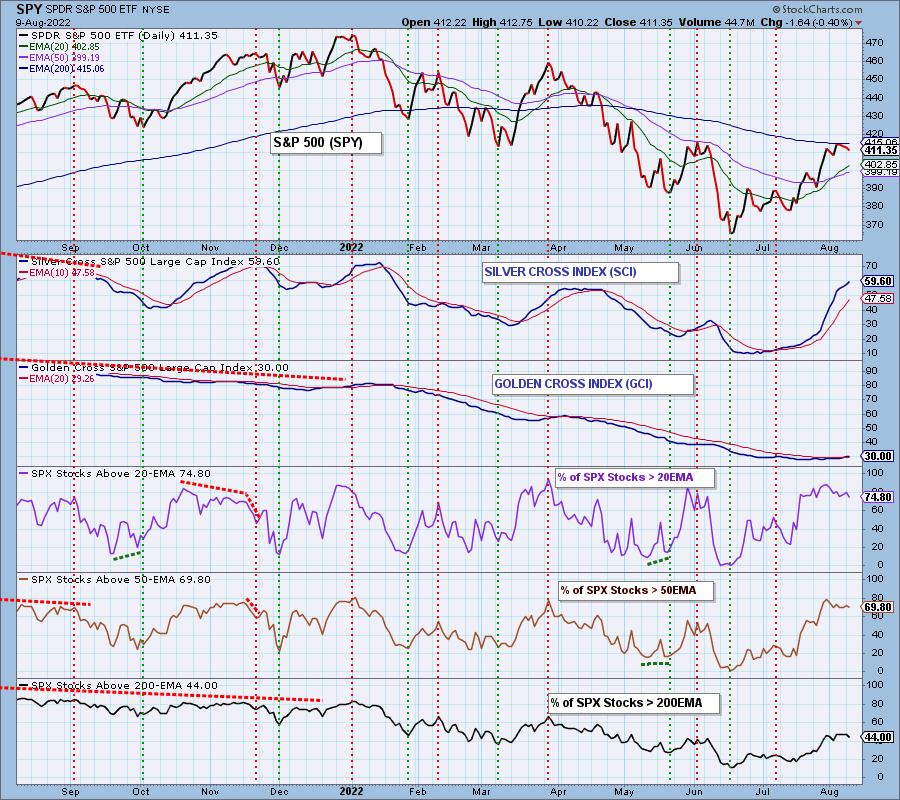
CONCLUSION: Bearish characteristics are starting to show with the STO-V and ITVM moving lower alongside the SPY's failure to overcome resistance at June highs. Cracks in the foundation are appearing and they should not be ignored. We are more cautious than yesterday, but overall indicators are still positive (RSI, PMO, Stochastics, VIX, etc.) There are still plenty of pockets of strength. In particular, as we noted in yesterday's DP Trading Room, Gold Miners and Renewable Energy have excellent upside potential.
Erin is 55% exposed, but will expand to 60% tomorrow.
Have you subscribed the DecisionPoint Diamonds yet? DP does the work for you by providing handpicked stocks/ETFs from exclusive DP scans! Add it with a discount! Contact support@decisionpoint.com for more information!
BITCOIN
As with the market, Bitcoin is forming a bearish rising wedge. Currently it is bouncing off the bottom of the pattern. Indicators are mixed. Stochastics are oscillating in positive territory as is the RSI. The PMO is turning up but has been mostly flat as Bitcoin oscillates within the wedge. We would look for another test of the upper bound of the bearish rising wedge followed by a breakdown.
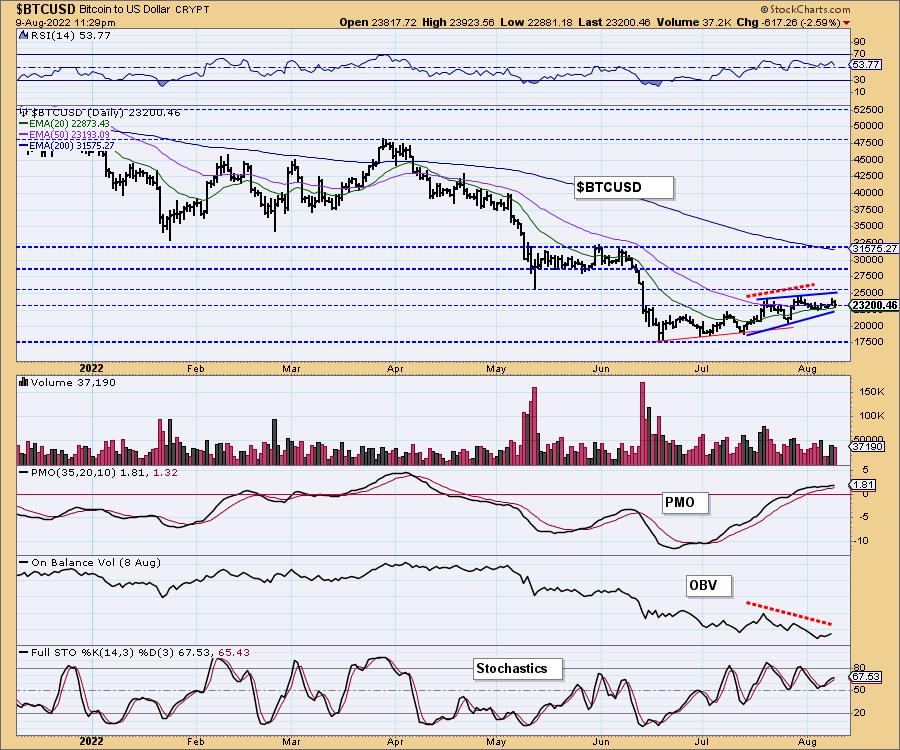
INTEREST RATES
Rates are sneaking back up as declining trends are tested.
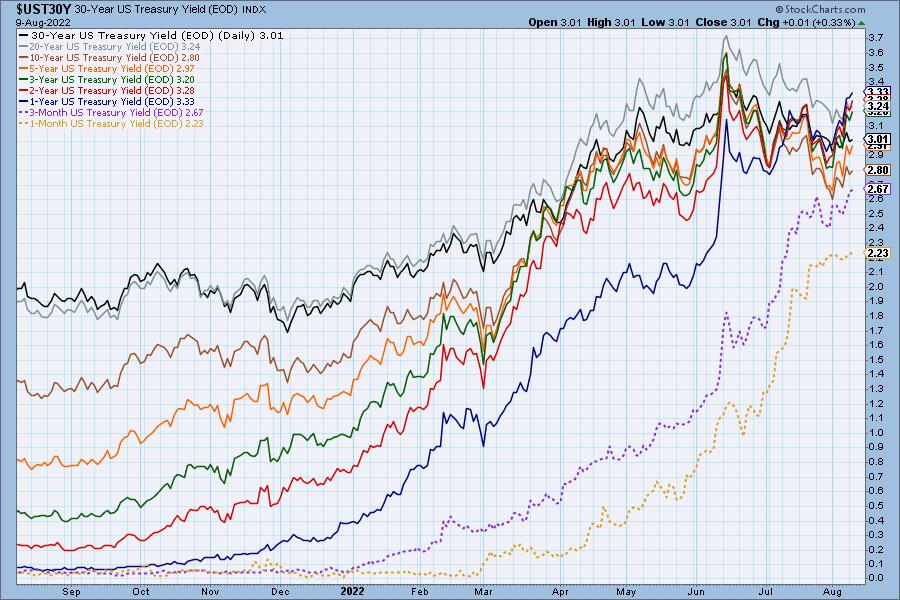
The Yield Curve Chart from StockCharts.com shows us the inversions taking place. The red line should move higher from left to right. Inversions are occurring where it moves downward.

10-YEAR T-BOND YIELD
We still have an overall declining trend on $TNX. An attempt at a rally occurred last week, but overhead resistance at the 20/50-day EMA is sturdy. Indicators are now beginning to look more positive. The RSI is still negative, but the PMO is nearing a crossover BUY signal. Stochastics are rising and nearing positive territory. The declining trend hasn't been broken yet, so we aren't ready to get overly bullish.

DOLLAR (UUP)
IT Trend Model: BUY as of 6/22/2021
LT Trend Model: BUY as of 8/19/2021
UUP Daily Chart: Yesterday's comments still apply:
"The Dollar is weak. It has basically been consolidating since mid-July. Indicators are mixed. The PMO is declining, the RSI is flat and Stochastics are rising very slowly. Sounds like a recipe for more churn and consolidation. So far the rising trend is holding up."
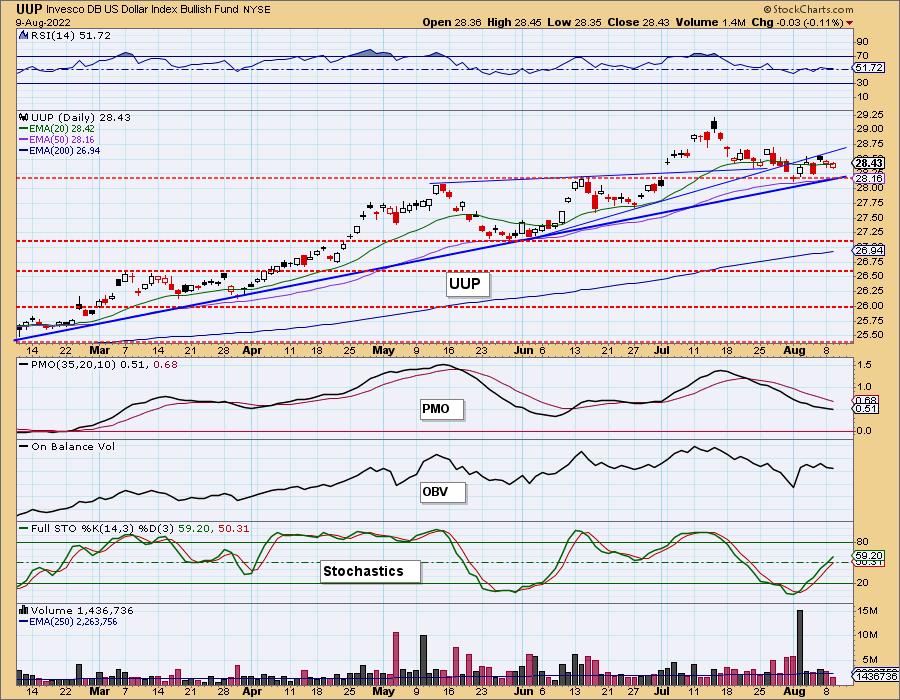
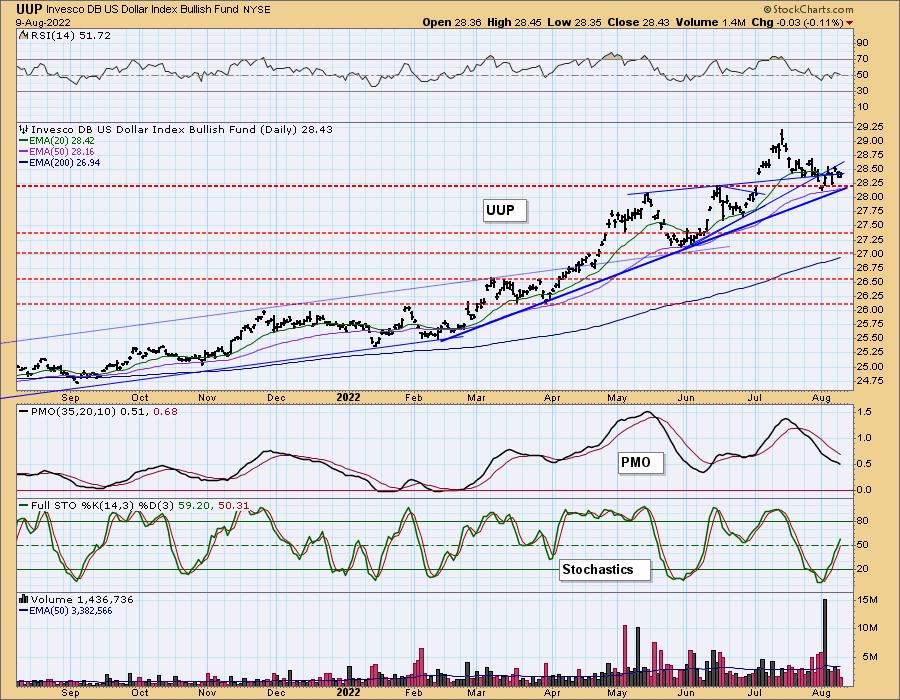
GOLD
IT Trend Model: NEUTRAL as of 5/3/2022
LT Trend Model: SELL as of 6/30/2022
GLD Daily Chart: Gold is now on a steeper rising trend. Today saw a bearish filled black candlestick on GLD. Overhead resistance is holding strong, but indicators look very bullish. We expect a breakout and test of the 200-day EMA soon.
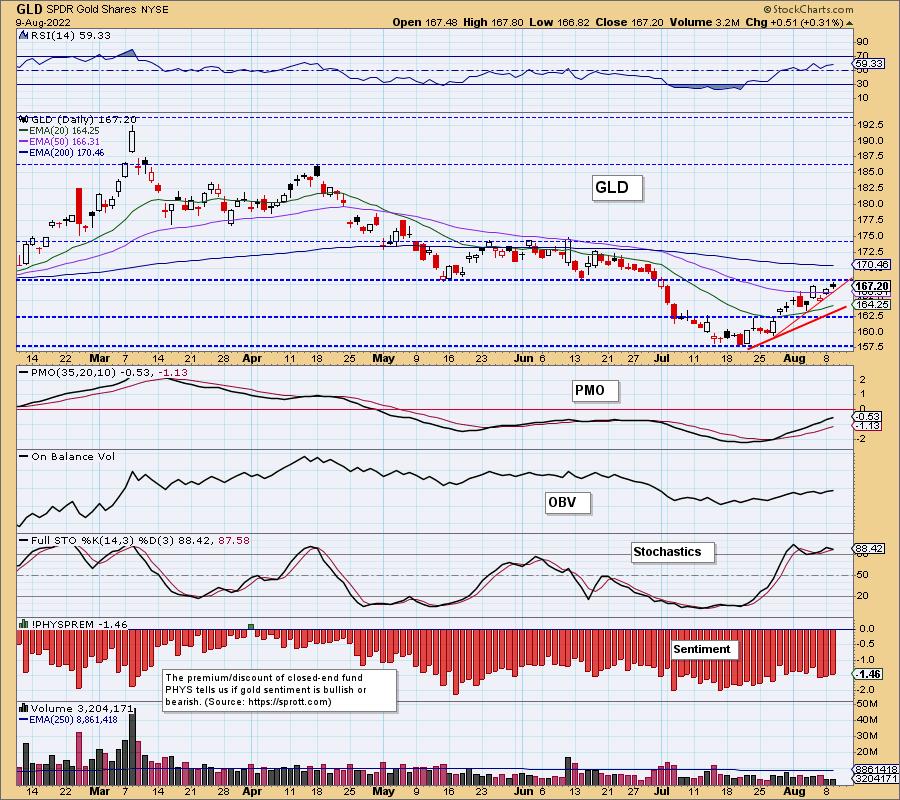
GOLD Daily Chart: Unlike GLD, $GOLD did break above resistance. Indicators are similar to GLD's so we expect both to move higher. Discounts are still high, but are paring back slightly.
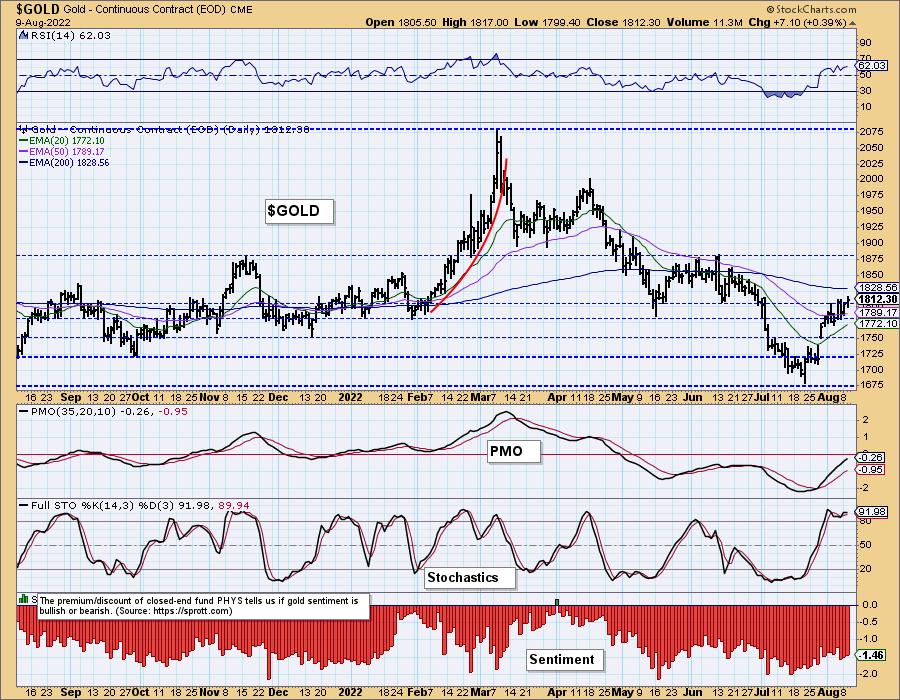
GOLD MINERS Golden and Silver Cross Indexes: GDX was down today, but no support was lost. There is a tiny reverse head and shoulders that executed on yesterday's breakout. Indicators are still positive and participation didn't see much deterioration. We do like this group based on the indicators and we are bullish on Gold. We should see higher prices here.
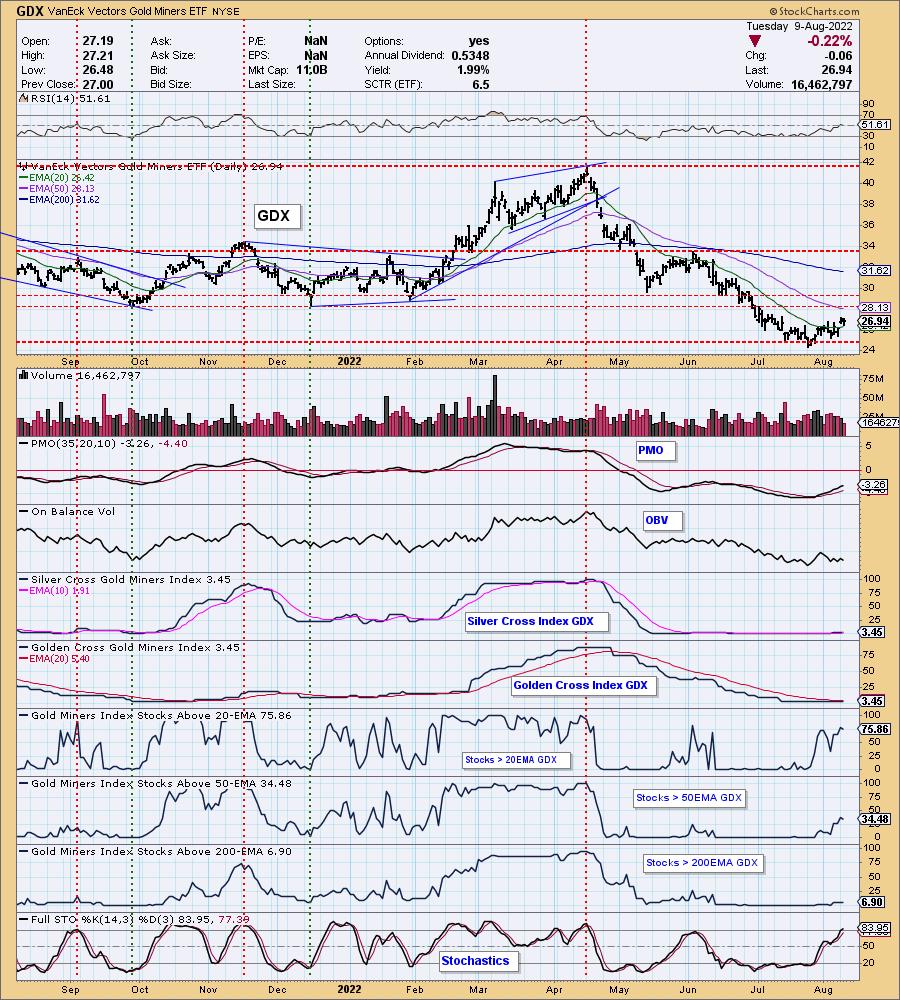
CRUDE OIL (USO)
IT Trend Model: NEUTRAL as of 7/8/2022
LT Trend Model: BUY as of 3/9/2021
USO Daily Chart: Crude Oil was down but is bouncing constructively off the 200-day EMA. We had higher highs and higher lows which is good. Indicators are mostly negative, but we do see small improvements on the RSI and Stochastics. We should see a test of overhead resistance at the 50-day EMA and late July top.
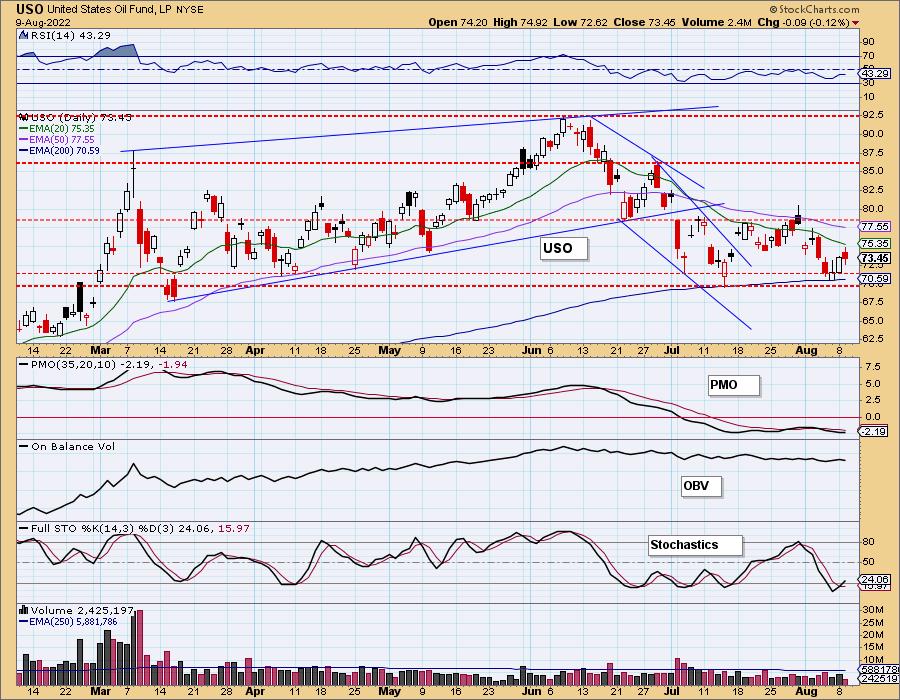
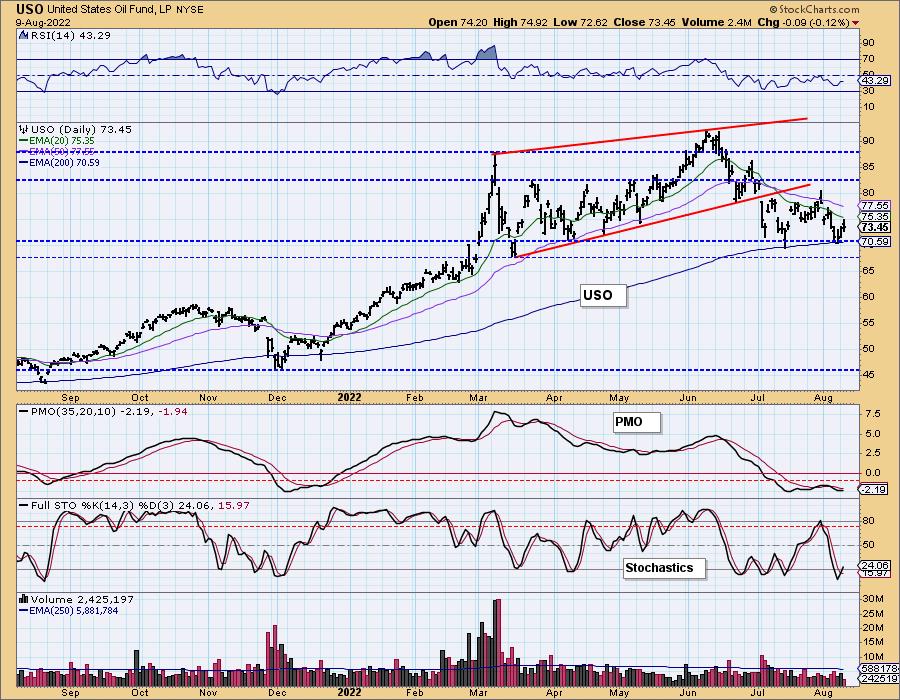
BONDS (TLT)
IT Trend Model: BUYas of 8/2/2022
LT Trend Model: SELL as of 1/19/2022
TLT Daily Chart: The short-term rising trendline is tenuous as we are seeing price drift out of the rising trend. Support is holding up and the RSI is positive. Unfortunately, Stochastics are in decline and the PMO is topping. Rates seem to be on the rise again so TLT will likely remain stagnant.
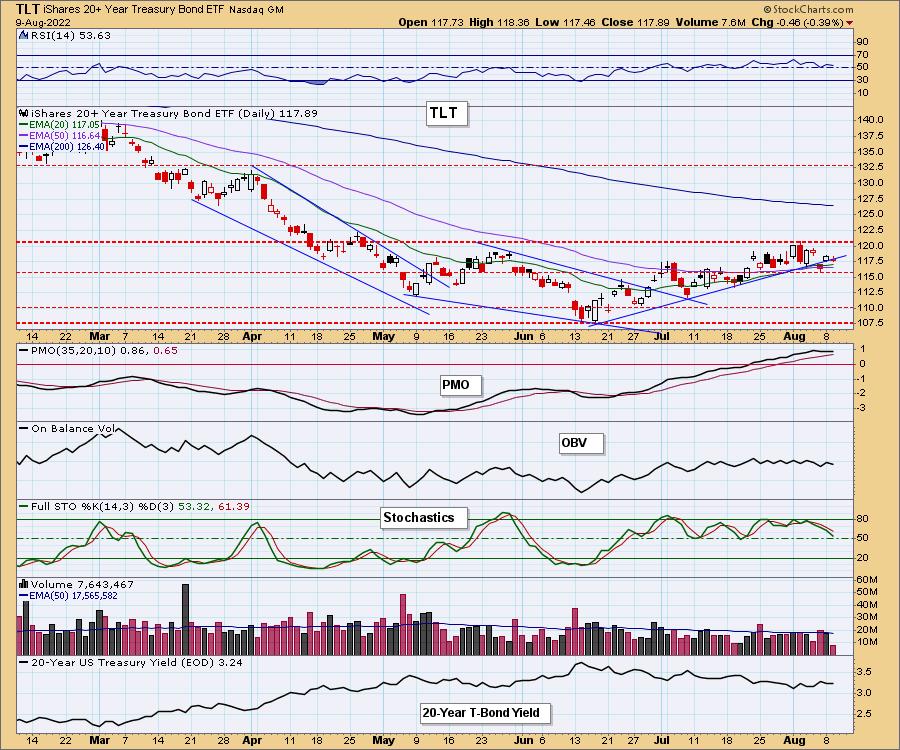
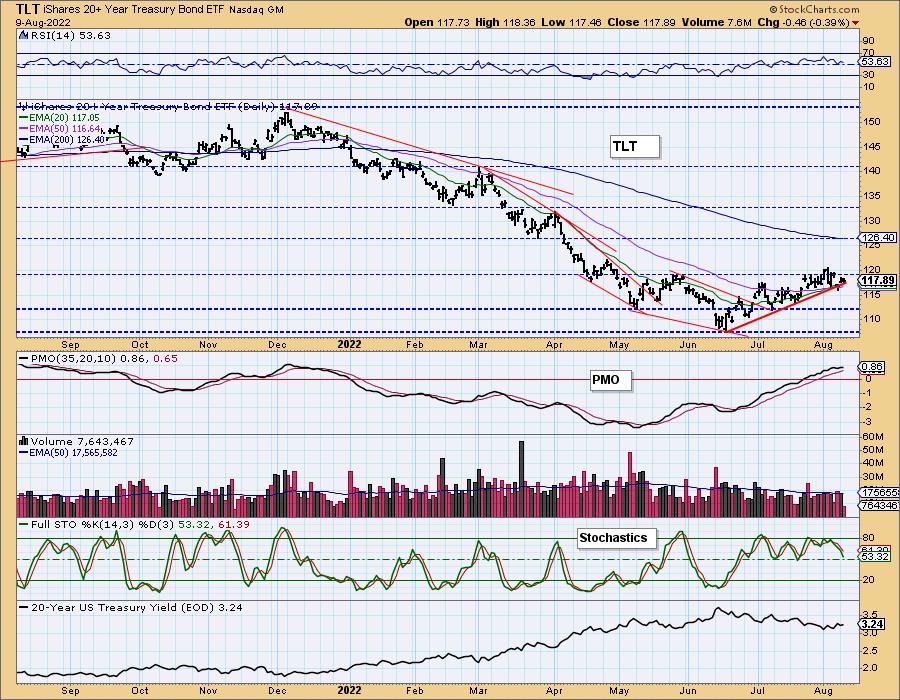
Good Luck & Good Trading!
Erin Swenlin and Carl Swenlin
Technical Analysis is a windsock, not a crystal ball. --Carl Swenlin
(c) Copyright 2022 DecisionPoint.com
Disclaimer: This blog is for educational purposes only and should not be construed as financial advice. The ideas and strategies should never be used without first assessing your own personal and financial situation, or without consulting a financial professional. Any opinions expressed herein are solely those of the author, and do not in any way represent the views or opinions of any other person or entity.
NOTE: The signal status reported herein is based upon mechanical trading model signals, specifically, the DecisionPoint Trend Model. They define the implied bias of the price index based upon moving average relationships, but they do not necessarily call for a specific action. They are information flags that should prompt chart review. Further, they do not call for continuous buying or selling during the life of the signal. For example, a BUY signal will probably (but not necessarily) return the best results if action is taken soon after the signal is generated. Additional opportunities for buying may be found as price zigzags higher, but the trader must look for optimum entry points. Conversely, exit points to preserve gains (or minimize losses) may be evident before the model mechanically closes the signal.
Helpful DecisionPoint Links:
DecisionPoint Alert Chart List
DecisionPoint Golden Cross/Silver Cross Index Chart List
DecisionPoint Sector Chart List
Price Momentum Oscillator (PMO)
Swenlin Trading Oscillators (STO-B and STO-V)
DecisionPoint is not a registered investment advisor. Investment and trading decisions are solely your responsibility. DecisionPoint newsletters, blogs or website materials should NOT be interpreted as a recommendation or solicitation to buy or sell any security or to take any specific action.
